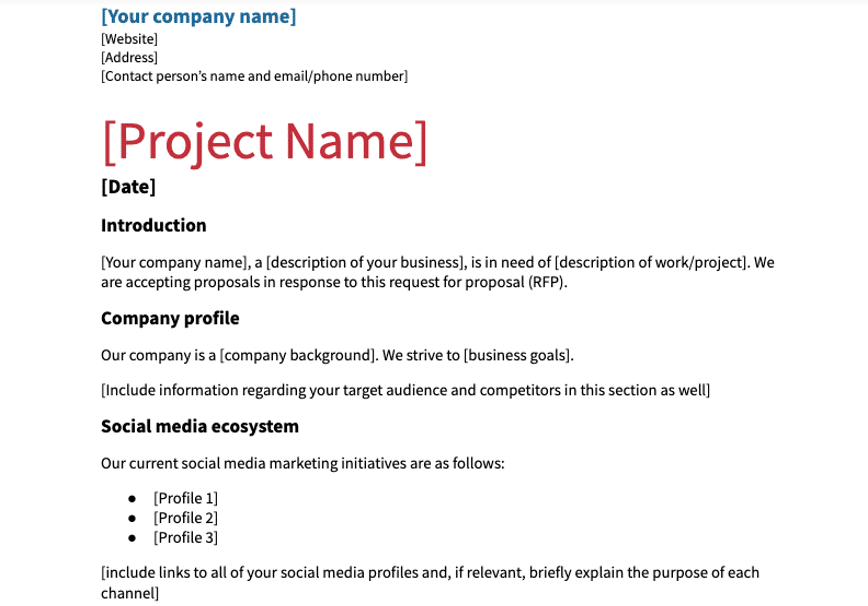
Social media RFPs are the starting places for solid social media strategies, award-winning campaigns and long-lasting collaborations.
But you get out of them what you put into them. Write a sub-par request for proposals, and the proposals you receive from digital marketing agencies will only be so strong.
Leave too many questions unanswered? Expect to spend time answering the phone and writing lengthy responses to emails from interested vendors.
Don’t waste your time or anyone else’s. Learn what information you should include in a social media RFP to attract the best companies and proposals for your business.
Bonus: Read the step-by-step social media strategy guide with pro tips on how to grow your social media presence.
What is a social media RFP?
RFP stands for “request for proposal.”
A social media RFP:
- outlines a specific project or need your business wants to address It
- invites agencies, management platforms or other vendors to pitch creative ideas or solutions.
The RFP process provides a way for a company to vet ideas and providers before committing to a significant collaboration or long-term agreement.
What’s the difference between RFP, RFQ, and RFI?
A request for quotation (RFQ) is focused on obtaining a quote estimate for specific services.
A request for information (RFI) is something a business may put out to understand the capabilities or solutions different vendors can provide.
An RFP should provide background, describe the project and its objectives, and spell out bidder requirements.
The art of an RFP for social media marketing services lies in providing the necessary amount of detail while leaving room for creativity. The better your RFP, the better vendor proposals will be.
What to include in a social media RFP
Still not sure what to include in your social media RFP? Every RFP is different, but these are the common elements that make for strong vendor proposals.
A social media RFP should include these 10 sections (in this order):
1. Introduction
2. Company profile
3. Social media ecosystem
4. Project purpose and description
5. Challenges
6. Key questions
7. Bidder qualifications
8. Proposal guidelines
9. Project timelines
10. Proposal evaluation
We’ve parsed out each section so you can get a better sense of what it should include.
1. Introduction
Provide a top-level summary of your social media RFP. This short section should include key details such as your company name, what you’re looking for, and your submission deadline.
Here’s an example:
Fake Company, Inc., the global leader of fake companies, is looking for a fake social media awareness campaign. We are accepting proposals in response to this fake request for proposal until [date].
2. Company profile
Share some background on your company. Try to go beyond the boilerplate and provide information that may be relevant to an RFP for social media marketing services. This may include your:
- Mission statement
- Core values
- Target customers
- Key stakeholders
- Competitive landscape
If including any of the above in your RFP would require disclosing trade secrets, note that additional information is available upon request and/or NDA signature.
3. Social media ecosystem
Give vendors an overview of how your company uses social media. Let them know which social channels you’re most active on, or which networks you’ve chosen to avoid. Some other things you might mention in this section may include:
- A summary of active accounts
- Important aspects of your social marketing strategy
- Overviews or links to past or ongoing campaigns
- Relevant social analytics (e.g. audience demographics, engagement, etc.)
- Highlights from your social accounts (e.g. content that performed really well)
A key reason to provide this intel is to avoid repetition. Without this information, you may end up with social media proposals that are too similar to past concepts, which is ultimately a waste of everyone’s time. The better a vendor can understand your social media landscape, the better they’ll be able to deliver a successful concept.
4. Project purpose and description
Explain the purpose of your social media RFP. What are you looking for? What goals are you hoping to achieve? Be as specific as possible.
Some examples may include:
- Promote awareness of a new store opening in [location]
- Gain new followers on a recently launched social media channel
- Increase consideration for an existing product or service
- Generate more leads via specific social media channels
- Establish your company as a thought leader
- Share company values or initiatives with a target audience
- Run a seasonal promotion or social contest
Remember, social media campaigns can and should include multiple objectives. Each goal provides a box for a vendor’s proposal to tick off. Consider using primary and secondary goal categories so that it’s clear what matters most.
5. Challenges
Most companies are well aware of the unique challenges they face on and off social media. Don’t assume that uninitiated third-parties will have the same understanding. Identify roadblocks upfront so you can work together to solve or work around them.
Challenges may include:
- Customer sensitivities (e.g. anything that would help a vendor avoid pressing known pain points)
- Legalese (e.g. cumbersome disclaimers and disclosures that often get in the way of creative concepts)
- Regulatory compliance (are there age or other restrictions associated with marketing your product?)
- Differentiation (is it difficult to differentiate your product or service from competitors?)
Resource and budget challenges may be relevant here, too. Does your company have enough staff to support necessary customer service and community management? Be honest. The best proposals could present invaluable solutions.
6. Key questions
It’s somewhat common to find questions in social media RFPs used for marketing purposes. They often follow or are included as a subsection in Challenges. In some cases, they simply ask: How will your proposal address these challenges?
Including questions is a way to make sure that proposals provide the solutions or answers head-on, rather than dodge or skirt around them. If your company faces significant challenges, these answers will make it easier to evaluate the proposals you receive.
Bonus: Read the step-by-step social media strategy guide with pro tips on how to grow your social media presence.
7. Bidder qualifications
Experience, past projects, team size and other credentials are important factors to consider when evaluating vendors who answer your social media RFPs. You’ve provided background on your company. This is where bidders share why their company may be uniquely qualified to take your project on.
Include qualifications that will make for a successful project, help you evaluate proposals and that are important to your business. For example, while it may not be pertinent to a social media RFP, your company may give preference to B Corps.
Some things to ask for:
- Details on the size of the vendor’s team
- Proof of social media training and certification (Hootsuite’s social marketing education and certificate program, for example)
- Examples of work with past or existing clients
- Client testimonials
- Results from previous campaigns
- A list of employees—and their titles—who will work on the project
- Project management approach and strategy
- Resources that will be dedicated to the project
- Anything else about the vendor and their work that is important to you and the execution of the project
If you disregard the bidder qualifications section, you might end up with a bunch of applications that lack the information relevant for you to make a decision. So include anything and everything you want to see from prospective vendors.
8. Proposal guidelines
This section should cover proposal submission basics: when, what, where and how much. Indicate the deadline for submission, how proposals should be formatted and the level of detail you require for budget breakdowns.
If your company has brand guidelines, social media guidelines, a social media style guide or any other relevant resources, include links or information on where vendors can find them.
Make sure to add a point of contact as well. Our social media RFP template puts contact information in the header. It ultimately doesn’t matter whether you put it first or last, so long as it’s available for agencies to direct questions or clarifications.
9. Project timelines
Every social media RFP should indicate proposal and project deadlines. In this section, provide a structured proposal schedule that vendors can follow. Unless your project is tied to a specific date or event, your project date can leave a little more room for flexibility.
A social media RFP timeline may include:
- Deadline to RSVP participation
- Meeting period with vendors for preliminary discussions
- Deadline for agencies to submit questions
- Proposal submission deadline
- Finalist selection
- Finalist presentations
- Selection of winning proposal
- Contract negotiation period
- When notifications will be sent to bidders who were not selected
Include a hard deadline or target project date. If key milestone and deliverable deadlines are already in place, that should be indicated here as well.
10. Proposal evaluation
Both you and prospective vendors should know ahead of time how their proposals will be evaluated. List the criteria that you will measure, and how each category will be weighted or scored.
Be as transparent about the process as possible. If a rubric template or scorecard is available, include it here. If evaluators will provide comments, let bidders know whether they should or should not expect to receive them.
Finally, indicate the role the stated budget will play in your decision-making process. Will it be revealed to evaluators after they’ve scored the proposal? How will cost vs. value be determined?
Social media RFP template
Need a social media RFP example? We’ve prepared a template to make things easy for you. Use this social media RFP template as a starting point, and tailor it for your needs.

Bonus: Get the free social media RFP template to create your own in minutes and find the right vendor to help you achieve your goals.
Save time managing your social media with Hootsuite. From a single dashboard you can easily:
- Plan, create, and schedule posts to every network
- Track relevant keywords, topics, and accounts
- Stay on top of engagement with a universal inbox
- Get easy-to-understand performance reports and improve your strategy as needed
Easily manage all your social media in one place and save time with Hootsuite.
The post Social Media RFP: Best Practices and a Free Template appeared first on Social Media Marketing & Management Dashboard.

